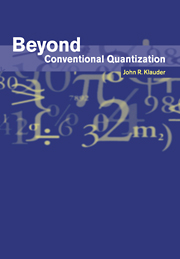Book contents
- Frontmatter
- Contents
- Preface
- 1 Introduction and Overview
- 2 Classical Mechanics
- 3 Hilbert Space: The Arena of Quantum Mechanics
- 4 Quantum Mechanics
- 5 Scalar Quantum Field Theory
- 6 Expanding the Data Base
- 7 Rotationally Symmetric Models
- 8 Continuous and Discontinuous Perturbations
- 9 Independent-Value Models
- 10 Ultralocal Models
- 11 Summary and Outlook
- References
- Index
2 - Classical Mechanics
Published online by Cambridge University Press: 15 September 2009
- Frontmatter
- Contents
- Preface
- 1 Introduction and Overview
- 2 Classical Mechanics
- 3 Hilbert Space: The Arena of Quantum Mechanics
- 4 Quantum Mechanics
- 5 Scalar Quantum Field Theory
- 6 Expanding the Data Base
- 7 Rotationally Symmetric Models
- 8 Continuous and Discontinuous Perturbations
- 9 Independent-Value Models
- 10 Ultralocal Models
- 11 Summary and Outlook
- References
- Index
Summary
WHAT TO LOOK FOR
In this chapter we introduce the subject of Lagrangian and Hamiltonian formulations, following descriptions that focus on action functionals and their stationary variation to arrive at the relevant equations of motion. Initially we deal with one degree of freedom, and then with finitely many degrees of freedom. These studies are standard and introductory to the case of an infinite number of degrees of freedom, namely the case of fields. In the classical theory, the infinite number of variables case can be approached as a limit of the finite number of variables cases as the number of those variables tends to infinity. This seems completely reasonable, and, more or less, may be taken as an unwritten rule of how to treat classical systems with an infinite number of variables. Unfortunately, as we shall learn much later, this unwritten rule will not always carry over to the quantum theory, at least in any obvious and straightforward fashion.
Lagrangian classical mechanics
Without undue exaggeration, the goal of classical dynamics may be said to be the introduction of dynamical equations of motion for point particles, or for entities that may be idealized as point-like particles, and the analysis of properties of the solution to such equations, i.e., the time-dependent path x(t) describing the classical motion.
- Type
- Chapter
- Information
- Beyond Conventional Quantization , pp. 6 - 18Publisher: Cambridge University PressPrint publication year: 1999



